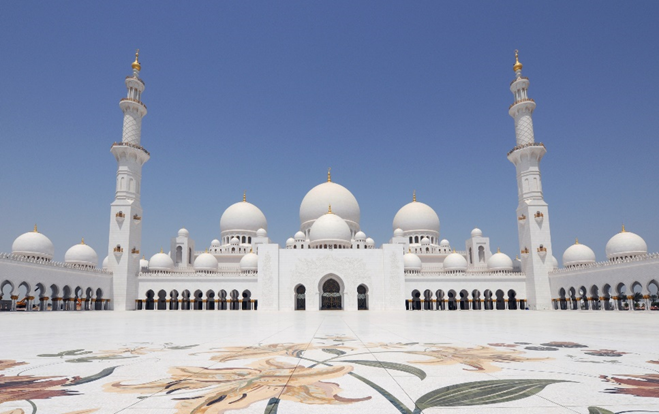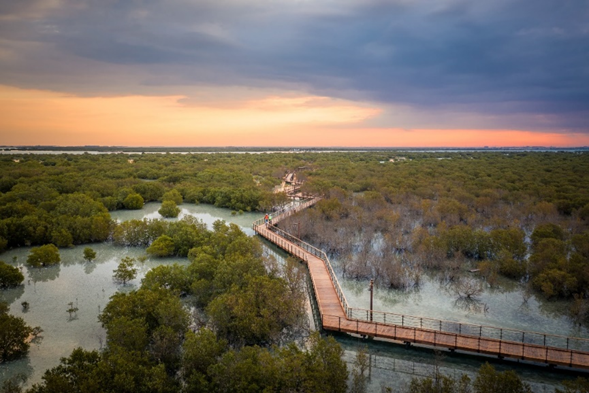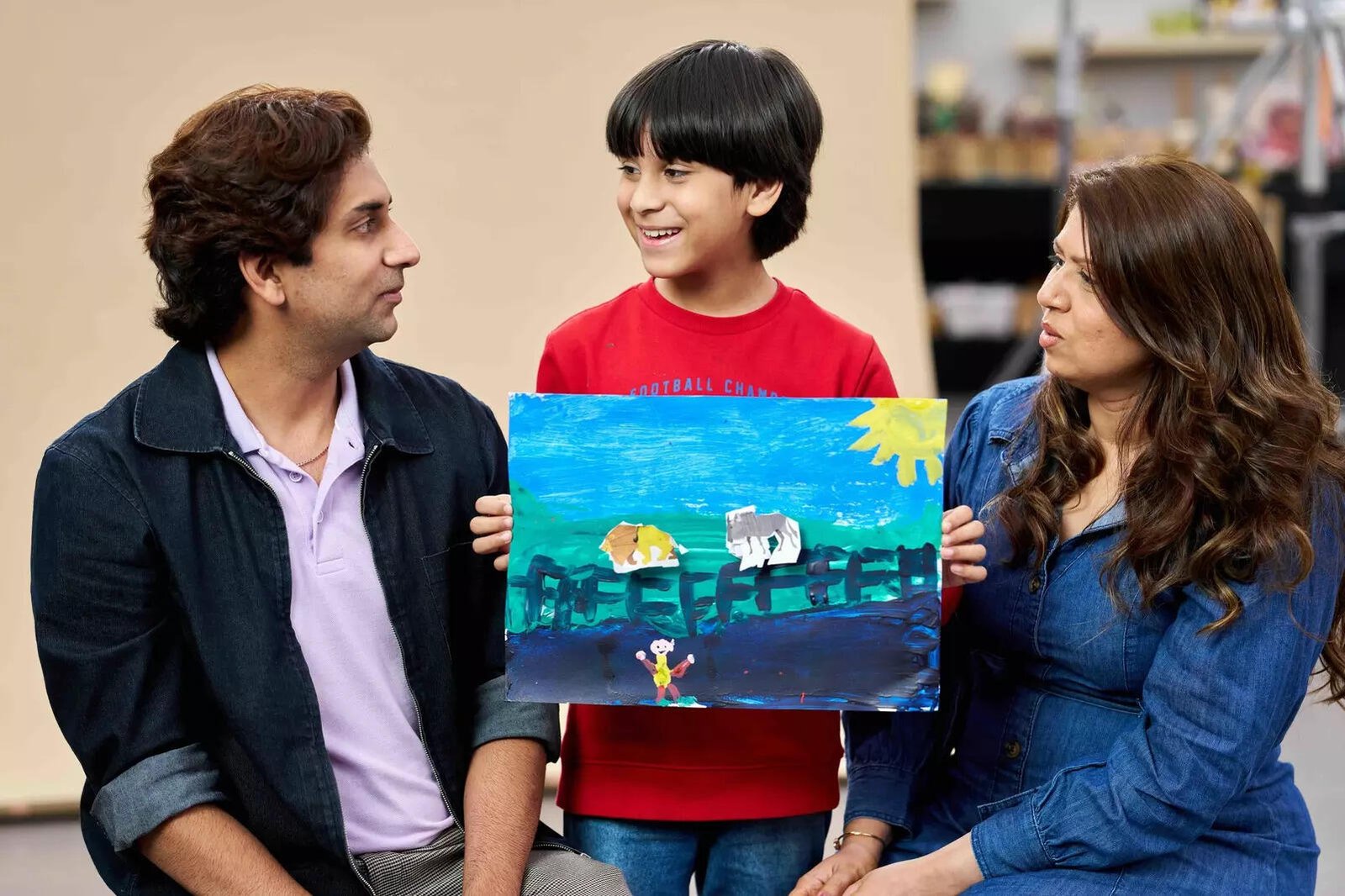Travel Trends
Cultural Curiosity Among Kids, ETTravelWorld

The travel industry’s assumptions about family holidays are being turned upside down by an unexpected demographic: children aged 5-12. Recent research commissioned by the Department of Culture and Tourism – Abu Dhabi (DCT Abu Dhabi) reveals that today’s young travellers are far more culturally curious than previous generations, with 93% of Indian children wanting activities that help them make new friends during holidays – a finding that’s reshaping how destinations approach family tourism.
Gone are the days when theme parks and cartoon characters dominated children’s travel wishlists. Instead, a striking 75% of Indian kids express a genuine interest in visiting museums, while an overwhelming 90% want to explore food markets during their holidays. This cultural awakening among young travellers presents both opportunities and challenges for destination marketers and tour operators targeting the lucrative Indian family travel segment.
Abu Dhabi, with its unique positioning as both a modern metropolis and cultural crossroads, appears perfectly positioned to capitalise on this trend. The emirate’s cultural landscape offers exactly what these curious young minds are seeking: authentic experiences that blend learning with adventure, tradition with innovation.
Standing in the courtyard of Sheikh Zayed Grand Mosque, watching families from around the world marvel at its 82 pristine white marble domes, the appeal becomes immediately apparent. This architectural masterpiece – one of the world’s largest mosques – isn’t just a tourist attraction; it’s a living classroom where children can observe Islamic culture firsthand. The mosque’s world’s largest hand-knotted carpet and stunning chandeliers create Instagram moments for parents while sparking genuine curiosity in young visitors about craftsmanship, faith, and cultural heritage. The research data aligns perfectly with what’s observable on the ground. At Qasr Al Hosn, Abu Dhabi’s oldest stone building and the birthplace of the city, families linger longer in the interactive exhibits than expected. Children particularly gravitate toward the fort’s storytelling elements, which bring Emirati history to life through multimedia presentations. The traditional Arabic coffee and date tasting that follows guided tours creates exactly the kind of cultural immersion that 90% of Indian children crave according to the DCT study.
“As both a parent and a marketer, I know firsthand how important it is to really listen to kids, to understand what lights them up, what sparks their imagination,” notes Nouf Mohamed Al-Bushlaibi, Executive Director of Strategic Marketing & Communications at DCT Abu Dhabi. This child-centric approach has led the destination to collaborate with kids to co-create its first-ever seven-day “Kid-Recommended” itinerary, featuring museums, cultural sites, and interactive experiences.
The culinary component of cultural exploration proves particularly significant. The Abu Dhabi Dates Market, featured in the emirate’s Culinary Kickstart Tour, exemplifies this trend perfectly. Here, local food experts guide families through tastings that showcase authentic Emirati flavours while explaining the cultural significance of ingredients and preparation methods. It’s precisely the kind of food market experience that resonates with 90% of Indian children surveyed.

The Louvre Abu Dhabi represents another strategic cultural asset. Its extraordinary collection spans thousands of years, from ancient civilisations to contemporary masterpieces, creating natural conversation starters between parents and children. The museum’s innovative approach to presenting global cultures in dialogue with regional heritage addresses the research finding that today’s young travellers want to understand “how people live” – a desire expressed by 80% of surveyed children.
What’s particularly noteworthy is how Abu Dhabi’s cultural offerings satisfy multiple preferences simultaneously. TeamLab Phenomena Abu Dhabi, with its immersive digital art installations that respond to movement, bridges the gap between technology and culture. It’s the kind of interactive experience that appeals to children’s natural curiosity while delivering sophisticated artistic content that engages parents.

The emirate’s positioning as a cultural hub will receive a significant boost with the December 2025 opening of the Zayed National Museum in the Saadiyat Cultural District. Designed by Pritzker Prize-winning architect Lord Norman Foster, the museum will house extraordinary artefacts, including the Abu Dhabi Pearl – one of the world’s oldest natural pearls – and the Blue Qur’an, among Islamic art’s finest manuscripts. These aren’t merely museum pieces; they’re storytelling tools that connect young visitors to thousands of years of regional history.
The museum’s design itself embodies cultural symbolism, with five steel structures inspired by falcon wings – falconry being integral to Emirati culture. This attention to cultural authenticity in architectural expression reflects the deeper trend driving young travellers’ preferences: they seek genuine cultural connections rather than manufactured entertainment.
The research reveals additional insights crucial for industry professionals. Beyond cultural curiosity, 96% of Indian children want water park experiences, while 79% express interest in adventure activities like climbing lessons. Abu Dhabi’s desert safari experiences in Al Danah successfully merge these preferences, combining dune bashing and camel riding with traditional Emirati dining and cultural performances. The mangrove kayaking at Jubail Mangrove Park offers another example of how the destination integrates adventure with environmental education.

For tour operators and travel agents, these findings suggest a fundamental shift in family travel product development. The traditional approach of segregating adult cultural activities from children’s entertainment no longer reflects market demand. Instead, successful family products must integrate cultural learning with adventure, social interaction opportunities, and authentic local experiences.
The fine dining scene also adapts to this trend. Fouquet’s Abu Dhabi, helmed by Michelin-starred chef Pierre Gagnaire, represents how upscale establishments can create family-friendly cultural experiences without compromising culinary excellence. The restaurant’s approach demonstrates that today’s families expect sophisticated experiences that engage all age groups.

Saadiyat Cultural District’s evolution into one of the world’s highest concentrations of cultural institutions positions Abu Dhabi uniquely in the global family travel market. With Louvre Abu Dhabi, teamLab Phenomena, the forthcoming Zayed National Museum, Natural History Museum Abu Dhabi, and Guggenheim Abu Dhabi, the district offers unparalleled cultural density.
The implications extend beyond Abu Dhabi. As destinations worldwide grapple with changing family travel preferences, the emirate’s research-driven approach to understanding young travellers provides a blueprint for cultural tourism development. The finding that 93% of Indian children prioritise friendship-making activities during holidays suggests that social interaction opportunities should be integral to cultural experience design.

For the travel industry, this represents more than a trend – it’s a generational shift toward experiential, educational, and culturally immersive family travel. Destinations that recognise and adapt to these evolving preferences, as Abu Dhabi has done, position themselves advantageously in an increasingly competitive market where cultural curiosity truly has become the new cool.
Travel Trends
Uzbekistan’s Overseas Tourism Growth: Record-Breaking Year for Outbound Travel Trends

Saturday, August 2, 2025
In recent years, Uzbekistan has witnessed a remarkable transformation in its tourism sector. More specifically, the growth of overseas tourism has been striking. Uzbekistan’s citizens are traveling abroad at rates never seen before, signaling a fundamental shift in the nation’s travel habits. This shift is reflective of the country’s economic progress, increased disposable income, and evolving preferences for international destinations. As Uzbekistan’s economy grows, so does the desire for its citizens to explore the world, marking a new era of outbound tourism.
Historically, Uzbekistan has been a country rich in culture, history, and natural beauty, but its citizens’ international travel has traditionally been limited. Several factors have contributed to this change, and understanding the elements driving this increase can provide insights into both the country’s growing tourism industry and the broader regional travel trends.
A Surge in Overseas Travel: Key Factors Behind the Growth
The significant rise in outbound tourism from Uzbekistan can be attributed to multiple factors that have created an environment conducive to international travel. First and foremost, the country has experienced a period of economic growth, which has translated into greater disposable income for citizens. This increased financial capability has enabled more individuals and families to afford overseas trips, whether for leisure, business, or cultural exchange.
Alongside economic growth, the liberalization of visa policies and international relations has played a crucial role. In recent years, Uzbekistan has made strides in simplifying visa requirements for many countries, making it easier for its citizens to travel abroad. Furthermore, partnerships with international airlines and the expansion of direct flight routes have improved access to foreign destinations. The availability of more flight options at competitive prices has made traveling internationally more affordable for many people.
The rise of digital technologies has also contributed to the surge in overseas tourism. The widespread availability of smartphones, internet access, and travel platforms has empowered Uzbek travelers to research destinations, book flights, and explore accommodation options more easily. Social media platforms and travel blogs have also fueled interest in international destinations, showcasing the experiences of fellow citizens abroad and inspiring more people to follow suit.
Moreover, the cultural shift toward valuing experiences over material possessions has influenced the decision of many Uzbek citizens to prioritize travel. Younger generations, in particular, are more inclined to seek adventure and exposure to new cultures, and overseas travel offers them the opportunity to broaden their horizons. As a result, destinations in Asia, Europe, and the Middle East have seen a noticeable increase in Uzbek visitors.
The Impact on Tourism Destinations Worldwide
Uzbekistan’s rise as a source market for outbound tourism has not only impacted the travel habits of its citizens but also left a significant mark on global tourism. Countries and regions that have long been popular among Uzbek travelers, such as neighboring Central Asian states and Russia, continue to see robust numbers. However, in recent years, the scope of destinations chosen by Uzbek travelers has expanded to include a variety of far-flung countries and continents.
The demand for international travel from Uzbekistan is helping to drive growth in regions like Southeast Asia, Europe, and the Middle East. Popular tourist destinations in Turkey, the United Arab Emirates, Thailand, and Malaysia have increasingly catered to Uzbek travelers, offering tailored experiences that align with the preferences of this new market. The appeal of exotic locations, world-class shopping, and cultural experiences has driven many travelers from Uzbekistan to explore further afield.
In addition to traditional vacation spots, there has been a growing interest in more niche forms of tourism. For example, wellness tourism, educational travel, and business tourism have all gained popularity among Uzbek travelers. As the middle class grows in Uzbekistan, so does the demand for more sophisticated and diverse travel experiences.
The Economic Impact of Outbound Tourism
As more Uzbek citizens engage in overseas tourism, the economic impact on the tourism industry both within Uzbekistan and globally is substantial. Outbound tourism represents a significant opportunity for Uzbekistan to increase its international profile. Many tourism experts suggest that this trend could eventually lead to the development of a robust outbound tourism market, which could generate foreign currency inflows for Uzbekistan.
The growth of outbound tourism is not only beneficial for Uzbek travelers but also for the economies of the destinations they visit. As more tourists arrive from Uzbekistan, the demand for goods and services increases in host countries, driving economic growth in those regions. The tourism industry benefits from the influx of spending, especially in the hospitality, transportation, retail, and entertainment sectors.
On the flip side, Uzbekistan’s tourism industry also benefits from the growing interest in travel. As Uzbek citizens become more exposed to international tourism standards and expectations, they are likely to seek similar experiences when traveling domestically. This could lead to the development of higher-quality tourism infrastructure and services within Uzbekistan, in turn benefiting the country’s growing tourism market.
Future Trends and Prospects
Looking ahead, Uzbekistan’s overseas tourism sector is poised for further expansion. The country’s growing middle class, coupled with ongoing improvements in international relations and travel accessibility, suggests that international travel will continue to be a significant part of Uzbek citizens’ lifestyles.
The government is likely to continue investing in policies and initiatives that support tourism growth, both domestically and abroad. With ongoing efforts to diversify its economy and enhance cultural exchange, Uzbekistan has the potential to become an even more significant player in the global tourism market. The rise of Uzbekistan’s outbound tourism is not just a passing trend, but rather a fundamental shift that reflects broader economic and cultural changes within the country.
Additionally, as international tourism becomes an increasingly important aspect of the country’s economy, Uzbekistan will likely strengthen its tourism infrastructure to support growing demand. This includes the improvement of air travel services, hospitality facilities, and the development of new tourist destinations that attract travelers both from within Central Asia and beyond.
For travelers, the rise in outbound tourism from Uzbekistan presents exciting possibilities for cultural exchange and exploration. The increasing number of Uzbek tourists abroad creates opportunities for deeper connections between countries and regions, promoting mutual understanding and collaboration.
Conclusion
Uzbekistan’s overseas tourism growth is a reflection of the country’s evolving economy and changing social trends. With increasing numbers of Uzbek citizens exploring destinations around the world, the travel industry is set to experience continued expansion. Factors such as economic growth, improved travel accessibility, and changing cultural attitudes have all contributed to this surge in outbound tourism.
As this trend continues, Uzbekistan will likely play an increasingly important role in the global tourism landscape, while its citizens benefit from new opportunities for travel and exploration. The future of Uzbekistan’s tourism sector looks bright, with an ever-expanding interest in international travel that promises to shape the country’s economic and cultural future.
Travel Trends
Annoying travel ‘bugbear’ prompted Aussie couple to pack their entire lives into a van | Exclusive

It was a simple observation that led this young Aussie couple to completely change their way of life.
Priya Sharma and her partner Sid Madiwale were travelling through New Zealand when they noticed something they had never seen in Sydney.
“Everywhere people were van-lifing,” she tells 9Travel, “There was just a ridiculous amount of vans on the road”.
READ MORE: Supermarket item Aussie flight attendant packs in her carry-on bag for every flight
So the next time they returned to New Zealand, they did as the locals do and rented a van, and in the process they discovered a comfort they had never felt before while travelling.
Priya’s number one bugbear while travelling was dragging suitcases around hotel rooms and back to cars, inevitably forgetting something.
READ MORE: ‘I’ve discovered an important secret no one tells you about cruising’
But with the van, “I never had to pack or unpack. All of my stuff was in the van”, she says.
“We could stop and just be in the most beautiful location ever, have a cup of tea, cook breakfast. It was truly the most simplest things about it. I felt like I was more in the moment, because there was so much I didn’t have to worry about.”
Even when the long-term couple returned to the little Queensland mining town where they both worked as explosives engineers, the idea persisted.
READ MORE: Booming travel trend will soon be worth $1.35 trillion – and it’s changing the way we holiday

Their rosters meant they would have seven days of work followed by seven days off, and previously they would rent “very average” motel rooms in larger cities to have a getaway. But their newfound discovery had them instead investing $8000 on a starter van.
“That way we would drive along the coast. We wouldn’t have to worry about booking a hotel. We just throw everything in our van,” she explains.
The process showed her just “how much I would not need a home.”
Their humble abode stores a lot more than you would expect, with the pair packing their summer and winter clothes, hiking gear, formal and Indian attire, kitchenware, and even their suitcases so that if they find themselves whisked away on an overseas adventure, they can do so on a whim.
READ MORE: ‘People say Bali is over. Here’s why it’s not.’

“I thought I would need more, and I don’t. I think that’s the biggest surprise when you live in a van,” says Priya.
As they settled into the new way of life, Priya began documenting the “renovations” they would do to the van to make it more like home on TikTok, where they gained a substantial following.
Eventually the couple were able to quit their day jobs and become “digital nomads”, roaming around the east coast of Australia while documenting their adventures.
It wasn’t all sunshine and rainbows though, especially when it was raining.
Their first van was “really miserable to live in” when a sudden shower would hit. The couple weren’t able to enjoy the creature comforts of a rainy day – like a nice long hot shower or a hot meal – since their cooking station was outside and they had a tiny shower.
READ MORE: Christchurch in a day: What to do with less than 24 hours

When they bought a new van, they made sure to utilise what they learned from the first time.
Their new van is fitted with an induction cooktop for safety, all of your regular kitchen gadgets like an air fryer, adequate counter space, a TV, and even internet.
Most of all, it was “important to us that Sid and I can sit and eat dinner together, so we have two little seats facing each other.”
READ MORE: Simple packing method that will make wheeling your suitcase around so much easier

Despite being in close quarters with Sid – who is not only her life partner of 13 years but also her business partner, with the pair selling her Dad’s Special Spice Mix around the world – the couple don’t tend to get on each other’s nerves.
“Historically, whenever partners work together, there’s a lot of clash… (but) I think because we had so much time where we were forced not to see each other… it’s our normal,” says Priya.
“I couldn’t imagine it any other way. I couldn’t imagine only seeing my partner for a few hours of the day. And that is a huge privilege, that we do get to spend all day together.”
READ MORE: One thing more and more Aussies are doing on holidays – and it saved my family holiday
Travel Trends
2025 Summer Travel Trends You Need To Know For Your Next Vacation

Friday, August 1, 2025
Heading into the summer season of 2025, tourists are getting ready to experience a diverse assortment of destinations and types of vacationing based on trends set off by concern over prices and anxiety about global unrest. From time-honored classics like Paris and Rome to more offbeat escapes such as Iceland and the Azores, it seems 2025 is set to be a year of adventure — with practicality in tow. Some may be influenced by the increasing price of travel, turning to value-oriented trips or simply staying closer to home. Below is a look at some of the key trends anticipated to influence summer travel five years from now.
Trending Destinations for Summer 2025
They revisit old bucket-list destinations, the first major trend for 2025. Domestic and international destinations alike are experiencing a surge in popularity, according to flight-tracking company Dollar Flight Club. Overseas, the top-of-mind destinations are cities such as Paris, Tokyo, and Rome, along with beach towns like Cancun and Bangkok. These cities, each with its unique elements from rich culture to beautiful landmarks and lively vibes, draw tourists in every year.
Traditional top destinations domestically, such as Honolulu, Orlando and Las Vegas, New York City, and Denver, are also popular this year. These famous names are still bringing in tourists for the sights, great family fun, and general “city goodness.”
The Emergence of “Coolcations” and Shorter Getaways
Cool, as in cold similar mindset has boosted the coolcation: People are craving a vacation that’s more chilled out and less crowded, which could mean going somewhere cooler (as in temperature). Closer to two-thirds of Americans live between Texas and Georgia. These spots provide relief from the summer heat, along with lots of outdoor activities and beautiful scenery. Destinations like Dublin, Edinburgh, Reykjavik, and Copenhagen are also drawing more bookings for travelers eager to experience cooler temperatures (or fewer tourists).
Another trend is the love affair with short, surprise trips showing no signs of weakening. In the post-pandemic world, travelers are predisposed to reserve fast getaways, sometimes involving long weekends. This corresponds with a wider appetite for flexibility and increasingly frequent getaways, as people opt for places that are just an hour or two away by car or quick flight.
Cost: Cheaper and cheaper options are being added all the time.
Travel costs continue to spiral, and this is impacting how people are holidaying, as they look for the cheapest ways to get away. Based on surveys from travel industry reports, many Americans are choosing closer-to-home vacations or shorter trips to keep their spending in check. Trends to consider in affordable destinations for 2025 would likely bring you places such as Portland, Maine, and smaller U.S. towns like Sedona and Jackson (anything but Mississippi).
Travelers are also becoming more strategic about where they stay, often choosing budget hotels or vacation apartments, or crashing with friends and family. That’s because the hospitality industry has become more expensive, and travelers are seeking ways to save money while still taking a summer holiday.
Labor Day Travel Trends: A Tale of Two Stories
When we look ahead to travel around Labor Day, two degrees of separation were pretty obvious: as soon as the flights venture across borders elsewhere. Domestic flights are relatively cheaper, with average prices 17 percent lower than in 2019, according to Dollar Flight Club. Las Vegas, Orlando, Phoenix, and Denver, cities that are affordable and offer plenty of fun things to do will see a significant boom in travelers.
But international airfare is climbing, with some routes demonstrating price hikes of 40-60% for the holiday weekend. To get around these prohibitive costs, travelers are looking at less costly options abroad, such as Calgary, Mexico City, and Lisbon, instead of the typical summer hotspots.
Adventure and Experience-Driven Travel
2025 is when active adventure and experiential travel assume the preeminent role for travellers in general. Interest in small-group adventure tours is also on the rise, particularly for places like coastal trails of the Azores and hiking routes through the Dolomites. This shift in mindset is especially common among younger travelers who are interested in immersion and personal development from travel.
In addition to these intrepid pursuits, there’s also an increasing demand for “maximalist travel,” as one jetsetter says she is seeing more and more of in recent years—travelers trying to pack everything they can into a single trip: hitting all the must-see spots and having every experience while visiting just one destination.
How Film and Social Media Have Affected Travel Decisions
There is no question that social media has been a driver of summer tourism decisions. Travel reports that 47% of younger travelers (aged 18-34) say their trips are inspired by social media, with the likes of Instagram and TikTok influencing where they visit. TV shows and movies have also been influential, driving travelers to the filming locations of popular series like “The White Lotus,” which is set in Hawaii, as well as Italy and Thailand.
It’s further evidence of the overlap between entertainment and tourism, as sites made famous in film, television, or literature draw growing numbers to visit – for better (and sometimes worse).
Crusing and Luxury travel: new trends for 2025
Cruise bookings are also beginning to rebound, especially for high-end cruises. For some travelers, a floating resort with boundless activities and seemingly unlimited new destinations is an alluring prospect. In terms of travel booking data, 2025 is set to see a spike in luxury cruises being booked, with the Caribbean and Mediterranean emerging as major winners.
Meanwhile, luxury travel is on the rise throughout Europe—destinations like Paris, Rome, and the Amalfi Coast still top lists for those in search of swanky digs and exclusive experiences. The trend demonstrates a continued appetite for luxury travel, even amid concerns about increased costs.
Economic Concerns and Travel Choices
Economic uncertainty continues to play a key role in summer travel planning. Many travelers are tightening their purse strings and seeking less expensive getaways, shorter trips, or more travel close to home. Record-high airfare prices and inflation are leading a lot of people to choose destinations that give them the most bang for their buck, but not at the expense of great experiences.
Tourists are getting pickier over where they want to allocate their funds—at times choosing dining, cultural excursions, and adventure experiences instead of expensive luxury accommodations or high-end shopping extravaganzas.
Conclusion: The Summer of Many Options
To recap, summer travel in 2025 will be influenced by a mix of timeless trips fit for the social media era and new ways to beat the heat on a budget — with an insatiable appetite for adventure. Travelers remain cautious as economic uncertainty looms, making more conscious choices with an eye to value, shorter trips, and cheaper options. Whether returning to familiar destinations or discovering new remote corners of the world, 2025 is expected to be a diverse and unpredictable travel landscape for those who are open-minded about it.
(Source: Travel industry reports, Dollar Flight Club, HotelPlanner, Emirates, Onefinestay, Enterprise Mobility, RateGain, U.S. News & World Report, MasterCard Economics Institute, Kayak, Google, Explore Worldwide, Squaremouth, Aon Affinity, Vacasa, Hilton, Tripadvisor, Allianz Partners, Kindred, Vacasa, Deloitte, Expedia, Whimstay, Trevolution Group, Pilot and Campspot, Harvest Hosts, RateHawk, LugLess, Lodgify, Fora Travel, Classic Vacations, WorldVia Travel Group, Trevolution Group, and Classic Vacations.)
-

 Brand Stories2 weeks ago
Brand Stories2 weeks agoBloom Hotels: A Modern Vision of Hospitality Redefining Travel
-

 Brand Stories1 week ago
Brand Stories1 week agoCheQin.ai sets a new standard for hotel booking with its AI capabilities: empowering travellers to bargain, choose the best, and book with clarity.
-

 Destinations & Things To Do2 weeks ago
Destinations & Things To Do2 weeks agoUntouched Destinations: Stunning Hidden Gems You Must Visit
-

 Destinations & Things To Do7 days ago
Destinations & Things To Do7 days agoThis Hidden Beach in India Glows at Night-But Only in One Secret Season
-

 AI in Travel2 weeks ago
AI in Travel2 weeks agoAI Travel Revolution: Must-Have Guide to the Best Experience
-

 Brand Stories4 weeks ago
Brand Stories4 weeks agoVoice AI Startup ElevenLabs Plans to Add Hubs Around the World
-

 Brand Stories3 weeks ago
Brand Stories3 weeks agoHow Elon Musk’s rogue Grok chatbot became a cautionary AI tale
-

 Asia Travel Pulse4 weeks ago
Asia Travel Pulse4 weeks agoLooking For Adventure In Asia? Here Are 7 Epic Destinations You Need To Experience At Least Once – Zee News
-

 AI in Travel4 weeks ago
AI in Travel4 weeks ago‘Will AI take my job?’ A trip to a Beijing fortune-telling bar to see what lies ahead | China
-

 Brand Stories4 weeks ago
Brand Stories4 weeks agoChatGPT — the last of the great romantics


















You must be logged in to post a comment Login